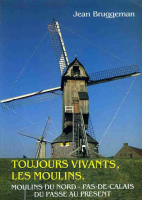Toujours vivants, les moulins: moulins du nord Pas-de-Calais du passe au present
Full details
| English title | Always living, mills. mills of the north, Pas-de-Calais of the past to the present |
| Authors & editors | |
| Publisher | Association Regionale des Amis des Moulins Nord - Pas-de-Calais |
| Year of publication | 1986 |
| Languages | French (main text) |
| Medium | Book |
| Edition | 1 |
| ISBN | 2950165508 |
| Topics | |
| Tags | |
| Scope & content | A guide to various types of mills specifically in the Northern area of France; both wind and water mills. Gives information on the processes of grinding grain; how paper mills were constructed and how they functioned from the first versions to subsequent adaptations. Also includes sections on how metals and other materials were produced. Also includes sections on how mills were used to pump and drain water. Discusses the main types of windmill. Pivot mills (Moulins sur pivot) were, arguably, the most popular. Gives information about how carpenters worked; how mills were constructed. There was never an official school of teaching the techniques and skills required for constructing mills; all information was given by word of mouth. Includes a chapter on the origins of wind mills and watermills. The first known mills were water mills in the mountainous regions in the Middle East. Slaves were used to create them and keep them working. Discusses abbeys and other religious sites where mills have been found. The first windmills are believed to have also been constructed in the Middle East, but the structures were very different to what most people consider to be traditional windmills. This variety of windmill still exists in Afghanistan today. Discusses key dates for the oldest windmills; dating back to 1180 in Normandy, 1181-96 in England, 1182-1195 in Flanders. The first illustrations, or pictures, of windmills date back to 1270. Also includes a chapter on mills in French society; the establishment of political movements, (banalité) and the impact they had on mills and milling; the development of new technology and techniques. Also mentions the decline of some mills as a result. Measures and regulations that were introduced for protection and security. For water mills, the regulations were much stricter. Includes information on mills and their traditions. They became symbols of a rich past; and became the centre of life in towns. Includes a section on disasters; when windmills were destroyed by fire, weather conditions or other factors such as the French Revolution and wars in France. Gives specific examples. Finishes with the chapters on the decline of mills, and their reconstruction. Gives information on the developments of movements to safeguard the mills. Specifically the creation of the A.R.A. M Nord-Pas-de-Calais. Gives information on how the movement, or society, was set up, the research they have carried out, and their projects to save and restore mills across France. Mentions Holland, and other groups which have worked with the A.R.A.M to preserve mills across 12 countries. |
Copies held
Accession no. 21681
- Shelf location: C111-BRU
- Donor: William Hill
- Advance notice required to view in person
Pictures

